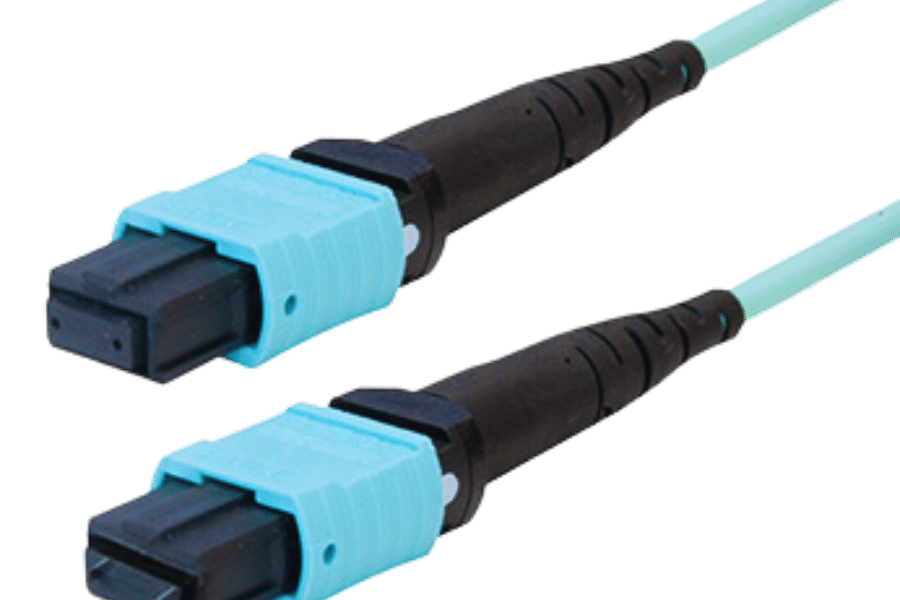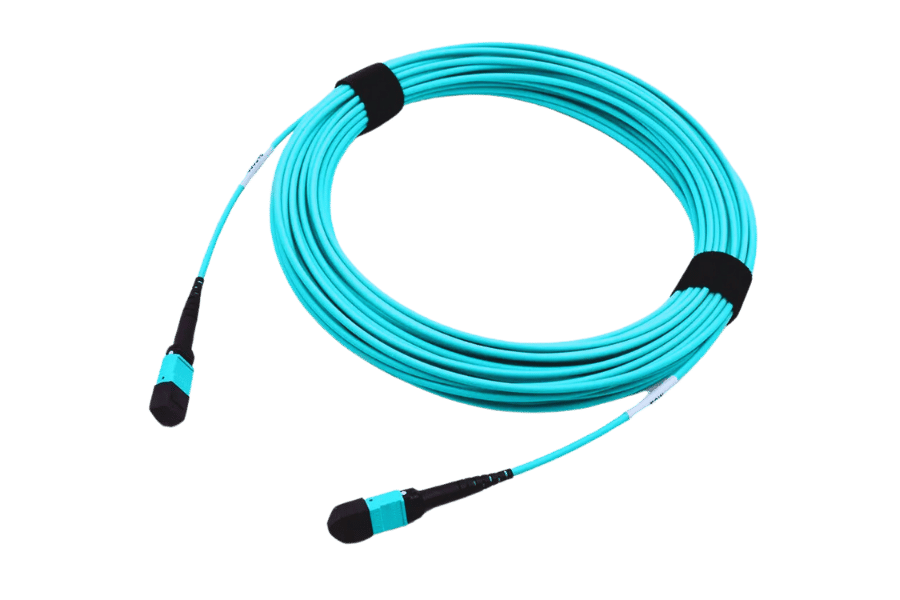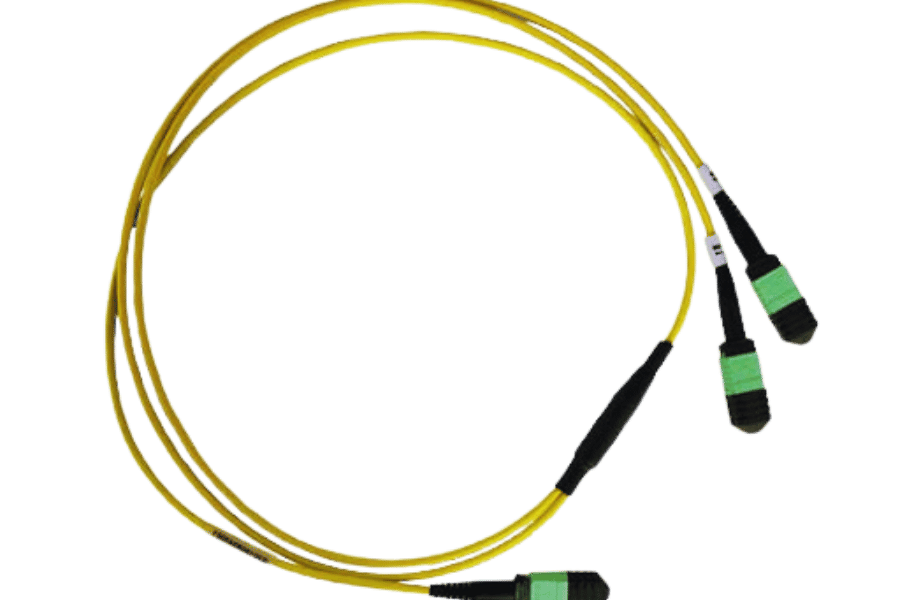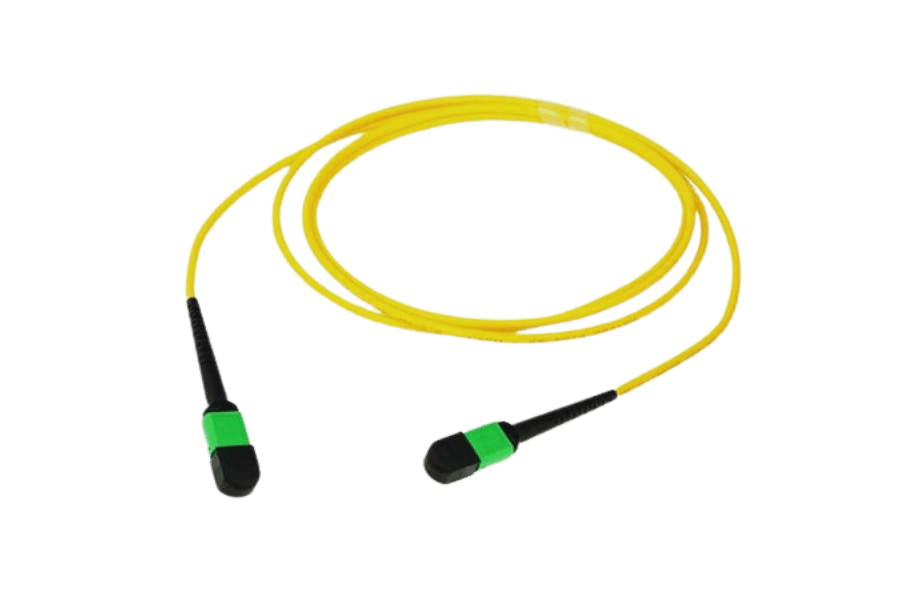In today’s world, which is governed by information, fast and reliable communication systems are increasingly becoming necessary. MPO 12 fiber optic cables are a key solution in modern networking environments as they offer wider bandwidths than traditional methods of cabling do, besides reducing latency. This blog post looks into technical specifications, benefits, and best practices for implementing MPO 12 fiber optic cables so that the readers can understand how these advanced systems can help improve network performance. Whether one is upgrading their current infrastructure or starting from scratch to design new networks, this article should provide the required information to ensure effective deployment of fiber optics according to one’s needs.
What is MPO 12 Fiber Cable and How Does It Work?

Understanding MPO Connectors and Their Role in Fiber Optics
The MPO (Multi-Fiber Push On) connector is designed to hold many optical fibers in one connector, with a common configuration being the MPO 12, which holds up to 12 fibers. These connectors make it possible for high-density interconnections, reducing cable management space significantly compared to LC or SC-type connectors. Passive optical interconnection is how MPO connectors work; this means that they allow accurate fiber alignment during assembly, resulting in minimum insertion loss. In scalable data center architectures, Multi-Fiber push-on connectors are essential because they provide an easy way of connecting trunk cables with patch cords while supporting different applications such as 40G and 100G Ethernet transmission. The fact that they are used shows us how critical precision can be when dealing with signal integrity maintenance and bandwidth capacity within fiber optic networks.
The Basics of 12 Fiber Optic Cable Construction
12 fiber optic cables are created with many closely packed fibers within a single jacket. Every fiber usually contains two parts: the core and cladding, made of glass or plastic, and guides light through total internal reflection. The core diameter typically used in single-mode fibers is about 9 microns, whereas multimode fibers range between 50 – 62.5 microns wide. A protective coating is applied around these threads, which may be made up of different materials such as strength-enhancing aramid yarns along with low friction outer jackets that protect against environmental factors like moisture or dust, among others. The main objective behind constructing twelve-fiber cable systems is to achieve flexibility as well as durability while ensuring minimum attenuation coupled with maximum performance during high-speed data transmission applications. These cables need to be handled and installed properly so that their integrity can be preserved because any wrong bending or stressing may cause a lot of signal loss.
Applications of MPO 12 Fiber Cables in High-Density Networks
Multi-fiber push-on (MPO) 12 fiber cables have become an indispensable part of high-density network environments today, especially in data centers and telecommunication infrastructures. They are built to enable quick deployment and scalability requisite for high-capacity networks. For example, in backbone connections between switches and routers where numerous channels with large bandwidths can be handled in a small space. MPO 12 fiber cables are used for both interconnection and cross-connect scenarios due to their ability to support 40G, 100G, and beyond.
In the performance aspect, usually MPO 12 cables maintain a low insertion loss of around 0.35 dB per connector, which is crucial since it helps in ensuring that signals do not lose integrity over long distances. Furthermore, they can house up to twelve fibers within one connector housing, thereby tremendously increasing the number of connections that can be made— frequently more than forty-eight connections per square meter on patch panels alone. Based on industry evaluations, using MPO 12 solutions could reduce cabling space requirements by half while improving cable management methods and airflow within densely populated areas. In summary, strategic utilization of multi-fiber push-on connectors with twelve fibers each will go a long way towards addressing current and future bandwidth needs for high-density networks, according to experts’ opinion.
Why Choose MPO 12 Fiber: Key Benefits and Features

High Density: Maximizing Space Efficiency
MPO 12 fiber cables are designed to be as space-efficient as possible in crowded networking spaces. Instead of using many separate connectors, MPO technology can fit up to 12 fibers into one. This means that traditional fiber optic cabling, which could have a 1:1 cable-to-connector ratio, might need multiple racks and more patch panel space. Using an MPO connector allows for the same number of connections in a fraction of the area.
Data centers have shown density improvements of up to 75% when deploying MPO 12 fiber configurations that can fit 144 fibers in one rack unit. Additionally, these cables are easier to manage so they do not create as much mess that would block cooling or airflow; which is very important because without this high-performance network devices will not work properly. The idea behind such high-density isn’t just about utilizing what’s given but also making it simpler for maintenance and scalability thus creating a more responsive network environment.
Plenum and LSZH Rated Cables: Ensuring Safety in Data Centers
Data centers need plenum-rated and Low Smoke Zero Halogen (LSZH) cables to be safe. Plenum-rated cables should be used in areas where there is a lot of air flowing, such as air handling ducts; they are made from materials with higher flame resistance and lower smoke generation — this protects people who work there and equipment when a fire happens. In contrast, LSZH cables emit hardly any poisonous gas when heated or burned it can reduce health problems associated with breathing smoky air. Using these two types of cable not only meets safety regulations but creates a safer working environment, too, which is very important for networking infrastructures’ success. While selecting what kind of wire to employ within data centers, one must consider the number of delicate gadgets concentrated in that area because failure to choose plenum or LSZH-rated cable could lead to loss of both human life and operational excellence as well.
Multimode and Singlemode Options: Flexibility in Fiber Types
To support different networking applications, multimode and singlemode fiber optic cables have unique advantages depending on the needs of a network. Multi-mode fibers have large core diameters that allow several light waves to pass simultaneously making them suitable for short-distance connections within enterprise networks or data centers. This kind is cost-effective and easy to install since it mostly uses light sources like LEDs or VCSELs which are cheaper than laser diodes used with single-mode fibers.
On the other hand, single mode fibers only permit one wave of light to travel through at any given time as it has a small core size. With this design, there is much higher bandwidth over longer distances hence being ideal for long-haul telecommunications where geographically diverse locations need high-speed data transfer between them. Normally more expensive because they require precise installation techniques alongside laser lights sources.
In conclusion, whether multi-mode or single-mode fiber cable types are chosen depends on distance among other factors such as budget and specific organization’s networking requirements. When you know these choices it helps in planning for infrastructure better so that diverse network environments can perform optimally.
Comparing MPO 12 Fiber Cables: OM4 vs OS2

Differences Between OM4 and OS2 Fiber Optic Cables
Networking infrastructure utilizes two different fiber optic cables; OM4 and OS2, each designed to meet specific performance needs. As a multimode fiber, OM4 has a core diameter of 50 microns which enables it to support high-speed data transmission over short distances. Data can be transmitted at 100 Gbps for up to 150 meters (492 feet) and at 40 Gbps for the same distance. This makes it ideal in data centers or enterprise networks that require fast rates over medium distances.
On the other hand, OS2 is a singlemode fiber with a core size of 9 microns. It is used for long-haul communication because it has better bandwidth than multimode fibers do. For example, while an OM4 may only maintain 1Gbps up-to 10km (6.2 miles), OS2 can transmit data at this rate over longer distances such as those found between cities in urban or intercity telecoms networks where there are significant amounts of information being exchanged between sites far apart from each other.
For short-reach applications where cost is important and less expensive options are acceptable, such as within buildings or campuses, om4 fiber has been optimized but offers limited capabilities beyond these scenarios due to its design characteristics. Conversely, when considering performance over distance, especially if cost isn’t much concern; os two fibers that are more costly but provide higher performances would be chosen instead since they can cover very large areas without any signal degradation happening along the way; thus, they should always choose wisely depending on the situation.
Performance Characteristics of OM4 Fiber
OM4 fiber optic cables have several performance features that make them ideal for short-range, high-speed data transmission. For example, OM4 fibers have a modal bandwidth of 4700 MHz·km at 850 nm, which allows them to support higher data rates and reduce modal dispersion at the same time. These cables can transmit data at 100 Gbps up to 150 meters (492 feet) and also at 40 Gbps up to the same distance. Moreover, it is a multifunctional cable since it sustains 25 Gbps and even 10 Gbps signals over longer distances. It is designed in such a way that ensures minimum signal loss during data transmission, where it attenuates approximately by 3.0 dB/km at a wavelength of 850nm. The other advantage of this type of fiber is its ability to handle multiple concurrent streams of information as well as being compatible with existing multimode infrastructures, thus making it suitable for use in data centers or campus networks that are characterized by high-density environments.
Advantages of OS2 Fiber for Long-Distance Transmission
OS2 fiber optic cables are designed for long-distance data transmission, so they are perfect for telecommunications and internet service providers who need high-performance infrastructure. One great thing about OS2 fibers is that they have an extremely low attenuation rate — only 0.4 dB/km at 1310 nm and 0.3 dB/km at 1550 nm. This means that very little signal strength is lost, allowing signals to be transmitted over long distances without needing extra repeaters; this can save a lot of money on installation and maintenance costs, as well.
Additionally, OS2 fibers can support higher data rates and larger bandwidths; it’s possible to send 100 Gbps or even 400 Gbps through them over longer distances than other types of cable would allow. They also have a single-mode design which lets more channels be transmitted simultaneously on different wavelengths — this is key for dense wavelength division multiplexing (DWDM) systems. Another advantage of OS2 fiber is its durability: these cables are built tough and can handle being installed outdoors or used in long-haul telecommunications where they may be exposed to harsh environmental conditions such as moisture or extreme temperatures. With all these features combined together into one product, it becomes clear why OS2 fiber optic cabling is often considered the best choice for those looking for reliable networks with high capacities over extended periods of time!
Installation Guide: How to Properly Set Up MPO 12 Fiber Cables

Step-by-Step Installation Process
- Preparation: Acquire the following equipment and tools: MPO 12 fiber cables, connector cleaning tools, and protective clothing.
- Site Evaluation: Inspect the site of installation to identify any possible dangers and to ensure it meets the standards set by relevant authorities.
- Cabling Routing: Develop a plan for routing the cable with a minimum number of bends and protecting it from physical harm.
- Cleaning Connectors: Clean MPO connectors using appropriate materials so as not to lose signals during installation.
- Terminating Connectors: Place fibers in the MPO connector, carefully aligning each one before terminating securely according to manufacturer instructions.
- Testing: Test continuity and signal levels correctness using an optical power meter together with light source which are connected at opposite ends respectively this will enable them give accurate readings about connection between two points.
- Documentation: Write down what has been done, such as results obtained after conducting various tests, among others. also, keep a record where necessary; all that pertains to this particular installation process should be recorded for future reference purposes only if need be; otherwise, don’t bother too much about it.
- Final Checkup: Thoroughly inspect every joint or connection made, ensuring they are well fixed as required, before closing up everything at the site.
Troubleshooting Common Installation Issues
- Signal Loss: If you are testing and find that there is signal loss, then the first thing to check is if all the connectors have been cleaned adequately and terminated securely. Also, take a look at the cable for any physical damage or sharp bends that might disrupt the integrity of signals passing through; replace damaged cables as necessary.
- No Connectivity: In case there’s no connectivity, confirm whether both ends of MPO assembly have been connected correctly with equipment. Inspect for any broken or loose connections which may happen during installation.
- Incorrect Polarity: Where a weak or absent signal is observed, establish whether the polarity is wrong. Any misalignment within MPO fibers can cause connections not to match; therefore refer to appropriate wiring scheme according to manufacture specifications.
- Intermittent Signal: To solve problems characterized by occasional loss of signals, check whole cable route for external interferences like electromagnetic interference (EMI) among others. Secure cabling correctly and keep it away from potential sources of disturbance.
- Environmental Factors: Always consider environmental conditions such as high/low temperatures or humidity levels since these may affect fiber optic performance adversely. If this is applicable in your installation site, think about following good practices on cable management and protection against them.
It’s important that we deal with these types of installation problems promptly so as not compromise network integrity plus performance at large.
Ensuring Proper Polarity During Installation
To maintain good signal quality over the fiber optic network, it is important to follow the correct polarity while installing MPO (Multi-fiber Push On) assemblies. Polarity may be achieved by observing wiring standards as per industry requirements like TIA-568. This means that one has to ensure that fibers are properly aligned in MPO connectors which normally use a specific color code for different fibers. In order to avoid errors during installation, it is recommended that both ends of an assembly should be labeled clearly. The last step before finalizing installation should involve checking if the polarity is correctly matched through testing connections with an appropriate light source or OTDR (optical time domain reflectometer). Technicians can be guided on how to prevent problems related to polarity by training them on a regular basis and by being aware of manufacturers’ installation guidelines.
Quality Testing and Warranty for MPO 12 Fiber Cables

Importance of Quality Testing in Fiber Optic Cables
Quality testing is important in fiber optic cables to ascertain their adherence to performance standards and efficient functioning within a network. There are three main purposes of quality testing: verifying signal strength, measuring loss levels, and locating faults that may degrade performance. Where applicable, routine tests should be done so as not only to keep the system intact but also to ensure it works well; they include insertion loss test, return loss test, and continuity check. Moreover, following industry guidelines like TIA or ISO ensures that the cable will reliably operate throughout its designed life span. An organization can reduce downtime, improve network efficiency, and lengthen the overall lifetime of its fiber optics infrastructure by adopting comprehensive quality testing procedures.
What to Look For in Warranty and Support
When assessing warranty and support for MPO 12 fiber cables, there are a few key things to consider in order to ensure that they’re reliable and protect your investment. The first thing to consider is the warranty, which should cover any defects in materials or workmanship for an extended period of time – typically around 15-25 years. Besides this, it also takes into account what is required by the warranty, such as installation conditions or maintenance needs that may affect coverage. Secondly, technical support availability matters too; make sure they have readily accessible channels where knowledgeable staff can be reached out for help when needed, like phone call helplines, email conversations, or even online chats. Last, but not least, ask about how easy it is to claim under their warranties because this greatly determines if potential issues will be resolved quickly or not. It’s, therefore, through these considerations that organizations can achieve strong backing up and confidence in their fiber optic systems.
Ensuring Reliable Performance with Certified Cables
To make sure that MPO 12 fiber cables are dependable in use, it is necessary to certify them against established standards. This means approved by the Certifying bodies, which will put them through some tests known as test protocols so as to verify whether they can meet required performance levels like attenuation or bandwidth, among others. TIA and ISO are some of the relevant organizations whose certifications should be adhered to since this not only shows that cable is of good quality but also guarantees its compatibility with existing setups. Additionally, one should always buy from well-known manufacturers who have been in business for a long time because such companies usually provide reliable products capable of working seamlessly with other network components without causing any drop-offs in performance over time. In other words, investing in certified goods together with related information will enable enterprises to achieve the best overall functionality and life span for their fiber optic installations.
Reference Sources
Frequently Asked Questions (FAQs)
Q: What are MPO 12 Fiber Optic Cables?
A: MPO 12 Fiber Optic Cables are cables of high density that have twelve strands of fiber. The cables are commonly used in areas where fast transmission speed and greater bandwidths are required, such as in telecom and data centers.
Q: What is the difference between Type A and Type B MPO cables?
A: When you hear of type A and type B MPO cables, what it means is polarity methods. For instance, b polarity or type B polarity (b-polarity) contains a crossover of fibre strands thereby making the duplex application simple.
Q: How long should my MPO cable last?
A: Different lengths of mpo cables fit different needs. Example include one meter, two meters and custom lengths. For example, in dense environments where short range connections are needed, you can use a 1 meter mpo-12 cable since it will serve the purpose.
Q: Why would I want to employ an MPO connector on each end?
A: These types of connectors are designed for high-density modules like cassettes and transceivers to provide stable and safe connection on either end with MPO connectors. They offer easy installation reducing deployment time and costs.
Q: Where do you normally find MPO 12 Fiber Optic Cables being used?
A: Typical applications for which they could be useful include high performance networks such as those found in telecommunications, data centres or enterprises. Examples include 40GBase-SR4 as well as 100GBase-SR10 that require high data rates.
Q: How do we use MPO cables with female connectors?
A: Modules, cassettes, and transceivers need to be connected through MPO cables with female connectors such as female-to-female cables. These cables ensure the cable link is uninterrupted and help maintain proper fiber alignment.
Q: What does a 12-strand fiber indicate in an MPO cable?
A: These types of MPO cables have twelve strands of fiber which enable them to carry very high data rates hence making them suitable for applications that require a lot of bandwidth. They are used in connecting multifiber interface devices between two high-density ports or modules.
Q: What does “MPO cables feature a lifetime warranty” mean?
A: In simple terms, the manufacturer provides a warranty against defects and product failures on these MPO cables throughout their entire lifespan. This gives assurance over the quality and dependability of the product.
Q: Can I use MPO singlemode for long-distance links?
A: Yes, singlemode (sm) MPOs can be used for long-distance links. They have low attenuation while transmitting signals over long distances; hence, they are preferred for such applications.
Q: What is an MTP connection, and how does it relate to MPO cables?
A: An improved version of traditional interfaces, the highly engineered MTP interface is used instead of plain old classic ones like most other connectors mentioned above. For instance, MTP® connectors are usually tougher than other connectors because they can accommodate higher quantities of fibers, thereby enhancing overall network performance.
